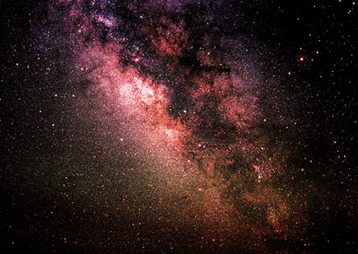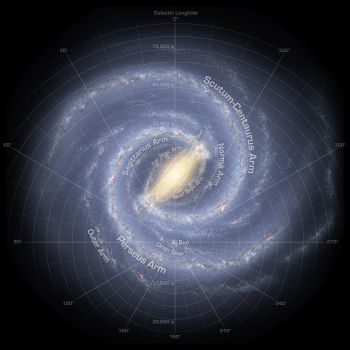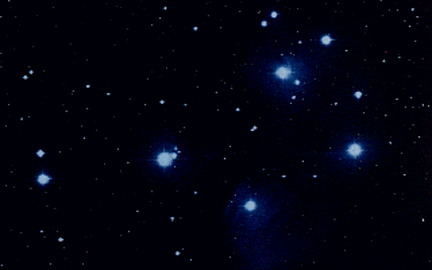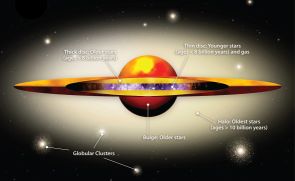
© Estate of Victor Winter (1953-2007)
(Used with permission granted in 1998)
Image of the Milky Way taken at 1996
Texas Star Party.

© Estate of
Victor
Winter (1953-2007)
(Used with permission granted in 1998)
Image of the Milky Way taken at 1996
Texas Star Party.
Our galaxy, the Milky Way, contains maybe 400 billion stars (plus or minus 200 billion) that lie mostly in a flattened spiral disk of some 70-100,000 light-years (ly) across, with a central bulge of about 10,000 ly in diameter. The sun, Sol, lies less than half way out (26,000 ly) from the galactic center in Sagittarius, on the core-ward side of one of the galaxy's spiral arms named after Orion that is some 2-3,000 ly thick. Roughly 6,000 ly separate the Orion arm from the Sagittarius-Carina arm on the inside and the Perseus arm on the outside. Sol is located 67 ly north of the galactic plane within a roughly 200-ly wide band that is rich in gas, dust, and newborn stars, particularly the associations of extremely bright, bluish, and massive O and B stars and emission nebulae (H II) that light up and define the spiral arms. The apparent voids between spiral arms are actually full of dimmer, redder, and less massive stars like Sol. From our perspective, the galactic rim is in the direction of Auriga and Taurus.
 Robert Hurt,
GLIMPSE,
Robert Hurt,
GLIMPSE,
SSC,
JPL,
Caltech,
NASA
Larger and
jumbo
illustrations.
The Milky Way has two
major and two minor arms
that spiral out from the
long bar of stars in the
central bulge, as well as
near and far arms that
lie along both sides of
the central bar
(more).
Looking in from outside the Milky Way, we would see the luminous parts of the galaxy. A dense concentration of mostly old stars fills the central bulge, whose brightest stars are red giants of relatively low mass and big bluish stars recently born from gas held tightly around the galactic center (towards an object called Sagittarius A* that may be a black hole massing about 2.5 million suns). The central bulge actually extends in a 12-18,000 ly long "bar" (2-3 times longer than it is wide) to two to four bluish spiral arms on opposite sides that wrap around the bulge and each other outwards through the dimmer and redder galactic disk, possibly including broken arm segments, yellowish "ghost" arms where most short-lived OB stars have already perished, and spurs off the arms (for example, the Orion "arm" containing Sol may actually be a spur of the Perseus arm). Surrounding the Milky Way's spiral disk and bulge is the slightly flattened galactic halo of old stars, averaging somewhat lower in mass than our sun, including a relatively small number of individual stars and 200 or so globular clusters -- roughly half above and half below the disk.
Our luminous galaxy, however, appears to be embedded in a larger and much more massive, but unseen, spheroidal halo of nonluminous material. The Milky Way may actually contain as much as the mass of a trillion suns like Sol, although the 400 billion, estimated luminous stars mass only about 175 billion suns. Thus, most of the galaxy's mass must be composed of "dark" matter, of which brown dwarfs, neutron stars, black holes, gas, and dust are estimated to make up only a minor share. The nature of the galaxy's "missing" nonluminous matter is still unknown.
Although as many as 5,800 to 8,000 of the Milky Way's stars are visible from Earth with the naked eye, it is seldom possible to see more than 2,500 stars at any given time from any given spot. Most of the "bright" stars that we do see are atypical, with more mass, a higher luminosity, and a greater diameter than our own sun. On the other hand, the vast majority of stars in Sol's neighborhood are dimmer than Sol, too dim to be observed with the naked eye. Although dim and reddish M-dwarf stars constitute more than half of the population of our galaxy's stars, none are visible to the naked eye.
The Milky Way, however, appears to be poised to enter middle age. While many younger galaxies can be grouped into "blue galaxies because their vigorous star formation produces a lot of young stars that are massive, bright, and bluish, older galaxies can be grouped into "red galaxies" where most short-lived, bluish stars have expired to leave redder, dimmer, less massive stars behind. Recent observations using infrared wavelengths indicate that the Milky Way appears to be of intermediate color, which can be grouped into relatively rare "green valley" galaxies, that are thought to be changing from blue to red as star-formation waning over 1.5 billion years (based on model simulations). If observations and model simulations are correct, star formation in the Milky Way will end within five billion years, despite the gas compression and star formation impact of a predicted merger with the neighboring Andromeda Galaxy (M31) beginning in 2.2 billion years and taking five billion years, which also appears to be transitioning into a green valley galaxy that is relativley poor in the cold gas needed for star formation (Mutch et al, 2011; and David Shiga, New Scientist, May 20, 2011).
NOMENCLATURE. Many bright stars have proper names. Most are Arabic names based upon the position of the star within the original Greek constellations -- which we refer to using Roman translations of the Greek names. Many bright stars lying within constellations have Bayer designations using the Greek alphabet (from Alpha to Omega, generally by decreasing brightness) and/or a Flamsteed number (beginning with 1, based on position in its constellation from left to right) and the genitive spelling of the Latin constellation name. (For example, the star "Keid" in Eridanus is more commonly known in the United States as Omicron2 or 40 Eridani A, where the number 2 indicates that there is another star in Eridanus designated Omicron1 and where the following letter "A" designates this star as the "primary" or most luminous star of a multiple star system.) In addition, many variable stars are also designated with capital letters (e.g., R or RR) in front of the Latin genitive for the nearest constellation.
Stars are also designated with catalogue numbers. While some begin with the cataloguer's last name (e.g., Ross or Wolf), most use just the first letter of the name(s), or some other abbreviation, to save space. Examples include:
| AC | Catalogue Astrographigue |
| AGC | Alvan G. Clark |
| ADS | Aitken Double Star |
| BS,HR | Bright Star/Harvard Record |
| DM: BD/B;CoD/CD/C;CP(D)/P | Bonner/Cordova/Cape Photographic Durchmusterung |
| FK5 | Fifth Fundamental |
| G,GD,GR | Giclas/white Dwarf/Red |
| Gl,GJ,NN | Gliese/& Jahreiss/Not Numbered |
| HD | Henry Draper |
| Hip | Hipparcos |
| Kui | Kuiper |
| L,LB,LDS,LFT,LHS,LP,LTT,BPM | Luyten/faint Blue/Double Star/Five-Tenths?(1955)/Half Second/Palomar/Two-Tenths/Bruce Proper Motion |
| PPM | Position & Proper Motion |
| SAO | Smithsonian Astronomical Observatory |
| San,SS,Steph | Sanduleak/Stephenson & |
| Sm | Smethells |
| Tyc | Tycho |
| USNO | U.S. Naval Observatory |
| V | Variable star or Vyssotsky |
| VB | Van Biesbroeck |
| Wo | Woolley |

David Malin
Anglo-Australian Observatory.
(Used with permission)
Image of the Pleiades.
SPECTRAL TYPE. Astronomers differentiate the stars by spectral type, a system of classification which indicates the star's predominant color, a reflection of its surface temperature. The sequence of the seven basic spectral types is denoted in capital letters, which have been translated visually by ChView into colors that exaggerate their actual tint, as derived from surface temperature, particularly at the extremes of the spectrum, in the bluish and reddish tints of the hottest and coolest stars, respectively. [New default colors can be selected -- or created -- for ChView display.]
| O | bluish-violet | Iota & Zeta (Alnitak) Orionis Aa |
| B | blue | Algol A, Regulus Aa |
| A | cyan | Sirius A, Vega |
| F | pale yellow | Procyon A, Eta Cassiopeia A (F9-G0) |
| G | yellow | Sun, Alpha Centauri A |
| K | orange | Alpha Centauri B, Epsilon Eridani |
| M | red | Proxima Centauri, Barnard's Star |
Each spectral type is further subdivided into 10 divisions from 0 through 9, hottest to coolest. Most stars are of type M, with diminishing numbers up to type O -- quite rare in our galaxy. About 90 percent of all stars are main sequence dwarfs of spectral type F through M (excluding 9 percent white dwarfs, 0.5 percent red giants, and 0.5 percent everything else). On the other hand, the average mass of main sequence dwarf stars rises dramatically from M to O.
The current version of CHVIEW consolidates stars of unknown spectral type as well as those of all other spectral types into "X". The non-OBAFGKM spectral types include reddish giants and supergiants that have become relatively rich in carbon, such as C (formerly R and N) and S types, as they have run out of hydrogen as the primary fuel for nuclear fusion -- none are currently believed to be located within 250 ly from Earth. WC (carbon-rich) and WN (nitrogen-rich) Wolf-Rayet stars such as Suhail (WC8, Gamma2 Velorum Aa) are massive stars (averaging 20 solar masses in binaries with O stars) that may have already expelled 40 percent or more of their original mass, including their entire hydrogen envelope. The extreme luminosity of Wolf-Rayets is obscured by the dust and gas shed by them.
Analysis of the spectral lines found in star light yields additional information, which is noted in lower case letters following the capital letter denoting spectral type. Examples include:
| e | emission lines |
| k | interstellar lines (chemical compounds in interstellar dust) |
| m | metallic lines |
| n | nebulous lines (e.g., rapid rotation) |
| p,pec | peculiar lines |
| s | sharp lines |
| v,var | variable lines |
| w | weak lines |
Some stars have stellar companions so close that they appear to be single stars. Analysis of the spectra from such stars may indicate Doppler shifts from the movements of the stellar pair, suggesting the presence of a companion star. Called spectroscopic doubles (spec.dou.) or binaries (SB), spectral lines found in their star light may be periodically doubled ("double-line" binary). If one star's spectrum is too faint to be seen, however, the spectral lines of the primary star may oscillate about a mean position ("single-line" binary). In astrometic binaries, the presence of an invisible companion is inferred from slight "wobblings" in the motion of the primary.
MASS & EVOLUTION. A star is probably born as a nebular cloud of gas and dust of interstellar size collapses, spinning inward via an accretion disk towards an increasingly dense core. While still obscured from view by dust, nuclear fusion may ignite at the center of these pre-stellar objects, as hydrogen is fused into helium. Proto-stars (pre-"main sequence," T-Tauri stars and Herbig-Haro objects, possibly R Coronae Australis/CD-37 13027 which may only be 27 ly from Sol) are born as the energy of hydrogen fusion pushes outward to balance the inward pull of gravity. Eventually, any surrounding -- possibly stellar amounts of -- gas and dust that remain around the star will be blown away by the star's radiation in T-Tauri winds, including much that may be infalling through its stellar disk and blown out in jets (that may be driven by an intense magnetic field) at the star's poles. Once fusion begins, planets may have only a few hundred thousand years or so to form from proto-planetary objects before the dusty circumstellar disk becomes too tenuous, and the star enters the main sequence. Young stars in the solar neighborhood include many OBA type stars such as Beta Pictoris (A3-5), which is young enough to have an easily detectable dust disk, Epsilon Eridani (a K2V with a dust ring as wide as 60 times the Earth to sun distance that is estimated to be between one half and one billion years old), the double-binary system of HD 98800 which has four main-sequence K and M stars that may be only 10 million years old.
Astrophysicists have concluded that, in order to sustain the nuclear reactions necessary to become a star, a gaseous body must have about 0.074-0.080 the mass of our sun. Currently, some astronomers have been defining smaller objects with between 0.013 and 0.080 solar masses (about 13 to 80 Jupiter masses) as "brown" dwarfs, especially those in particularly eccentric orbits around a star since such objects probably formed at about the same time as the star from the same nebular cloud. (According to at least one theory, a "super planet" that is detected in a close-in orbit could be either a brown dwarf or a gas giant that formed after the birth of the star from a dust disk but migrated inward as the result of friction with dust or some other mechanism.) While at least one theory predicts a huge number of brown dwarfs, their dimness make them difficult to detect and few discoveries were actually confirmed until recently. In 1995, however, a brown dwarf companion to Gliese 229 (only about 19 ly distant) was not only confirmed by the international astronomical community but also photographed by the Hubble Space Telescope; by late 1996, at least 12 were found within 250 ly of Earth -- even more if farther objects are counted.
Most stars begin their life as "dwarfs" and spend the bulk of their lifetime in the main sequence with the same spectral type. As a star ages within the main sequence, however, it can become more as well as less luminous. Once a star moves off the main sequence, it will eventually swell so large that it's surface temperature will drop enough to shift its spectra dramatically downwards. Some large stars will shift spectral class down and back up more than once, as they shed mass through stellar winds and outbursts like nebulae and novae and shift from core hydrogen fusion (e.g., to helium, carbon, then oxygen) as their primary source of radiant energy.
Roughly 90 percent of all dwarf stars have a mass between 0.085 (M8) and 0.8 (G8) in theory -- such as Tau Ceti (G8p) -- of that of our sun, Sol. About 10 percent of the stars, including Sol (G2), lie within the intermediate main sequence. While the lower limit of this range is 0.9 solar masses, the upper mass limit is uncertain, somewhere between six (B5) and 10 (B2) solar masses in theory.
Most of the stars discussed thus far will swell up and become giant stars for a period of about 20 percent of their main-sequence lifetime, as they use up their core hydrogen and begin fusing helium then heavier elements at higher temperatures. Our own sun will leave the main sequence by expanding from its current diameter of about 0.01 of an astronomical unit (AU) -- 1/100 of the distance from the Earth and to the sun -- to as much as one AU. Eventually, these giant stars will literally puff off their cooler outer layer of mostly unfused hydrogen into interstellar space as planetary nebulae, leaving behind the dense cores called "white" dwarfs that are as small as, or smaller, than the Earth in diameter but with 0.5 to 1.4 solar masses.
Less than one percent of all stars lie in the upper main sequence, between about eight (B3) and 120 (O3) solar masses in theory. These stars quickly consume their core hydrogen, swell up into larger "supergiants," but may blow up in supernovae. The end result of such explosions may be a neutron star (1.4 to six solar masses) or a more massive a black hole.
Small, cool, and faint M stars -- such as nearby Barnard's Star (M3.8) which may already be around 10 billion years old -- may last for 50 billion years or more before cooling into black dwarfs. However, the more massive a star is, the faster it consumes and sheds its mass, and the shorter it "lives" as a star. [The lifespan of a star is a function of their mass (or energy supply) and luminosity (rate of energy consumption) -- roughly proportional to 1/Mass raised to the power of 2.5.] The hottest and most massive stars may use up their hydrogen at such a pace that they last less than a million years, short compared with our sun's expected lifetime of about 10 billion years -- still about five billion to go. Vega, type A0, may live only one billion years; a type B star may live for 30-some million years; and the massive O types may last only as long as three to four million years. Hence, the OBA stars observed in our skies are relatively young stars compared with redder spectral types, and any planets found around these stars are unlikely to have had the time to have evolved multi-cellular lifeforms similar to those found on our 4.5 billion-year-old Earth. Since the estimated age of our galaxy is about 13 billion years or less, none of the lower mass stars (M to G8) have had time to fade from view, but most of the previously born, higher mass stars (B to O) have already perished.
Stars also are assigned luminosity classes:
| 0 | Hypergiants | V810 or Omicron1 Centauri (?) |
| Ia,b | Supergiants | Antares Aa, Canopus |
| IIa,b | Bright Giants | Dubhe A, Tarazed |
| IIIa,b | Giants | Aldebaran Aa, Arcturus |
| IVa,b | Subgiants | Procyon A, Beta Hydri |
| Va,b | Main Sequence Dwarfs | Sol, Sirius A |
| VI/sd | Subdwarfs | Kapteyn's Star |
| VII/D | "White" Dwarfs | Procyon B, Sirius B |
This classification system is perhaps a better indicator of a star's relative age and stage of evolution within its class as well as of its mass. Subdwarfs, such as nearby Kapteyn's Star (M0VI or M0sd), are more bluish than younger main-sequence dwarf stars and have a lower "metals" content of elements heavier than helium -- perhaps due to their birth in an earlier age (or region) of the galaxy when relatively few supernovae had as yet spewed their metals into surrounding dust clouds. Most of the stars in the central bulge and in the globular clusters of the galactic halo are old, low metals stars.
LOCAL STARS & STELLAR POPULATIONS. Stars in the solar neighborhood include representatives of the two major stellar populations of the galaxy, disk and halo stars.
Including the stars of the distant globular clusters, halo stars are among the galaxy's oldest, thought to be mostly 10 billion years and older. While halo stars are only very weakly concentrated towards the galactic plane, they exhibit a strong concentration towards and including the galactic nucleus but with highly eccentric orbits. These stars contain a very low metals abundance relative to the sun (with a mean around 0.02 of Sol's). Not surprisingly, there are very few halo stars are in the solar neighborhood (perhaps as low as 0.1 percent), but they include local subdwarfs, Kapteyn's Star (M0VI or M0sd) and Groombridge 1830 (a G8VIp with "superflares" that is now believe to be a single star -- no M-type flare star companion). Also called Population II stars because of their later discovery, this group also includes RR Lyrae variables with periods greater than 12 hours, subdwarfs and other extremely metal-poor stars, and some red giants.
Often called Population I stars, the relatively younger stars of the galactic disk can be further subdivided into four distinctive groups: very young spiral arm; young thin disk; intermediate-age disk; and older thick disk and nucleus. As mentioned previously, the spiral arms include most of the galaxy's interstellar gas and dust, young stars, and stellar associations, including: O and B stars; supergiants; Cepheid variables; pre-main sequence, T-Tauri stars and Herbig-Haro objects (e.g., R Coronae Australis/CD-37 13027); and some A stars. Less than a hundred million years old, these stars are rich in metals (as rich as, but ranging up to twice, Sol's abundance) and have highly circular galactic orbits within 1,000 ly of the galactic plane. While often extremely bright when not obscured by dust, these stars probably total substantially less than one percent of all Milky Way or nearby stars.
 Robert Gendler,
Amanda Smith,
IoA,
Cambridge U.
Robert Gendler,
Amanda Smith,
IoA,
Cambridge U.
Larger and
jumbo image.
Spiral galaxies like the Milky Way and its largest neighbor,
Andromeda,
have large central bulges of mostly older stars,
as well as a relatively young thin spiral disk (surrounded
by older, thick disk stars that may have come from mergers
with satellite galaxies) and a
luminous halo that includes
numerous globular clusters
(more).
Young thin disk stars lie within 1,500 ly of the galactic plane and have galactic orbits of low eccentricity. Around one billion years or more in age, they include many A and F stars, AFGK giants, some GKM main-sequence dwarfs, and white dwarfs. While they have a mean metals abundance near Sol's (1.0), some may be twice as rich. Totalling as much as nine percent of all stars in the solar neighborhood, they include Sirius2 (A0-1Vm and A2-5VII -- also DA2-5) and Vega (A0Va).
Intermediate-age disk stars include our Sun (G2V), most G and some K and M dwarfs, some subgiants and red giants, and planetary nebulae. Many are around five billion years old and have a metals content ranging from 0.5 to 1.0 of Sol's (with a mean around 0.8). These stars lie within 3,000 ly of the galactic plane, with moderately eccentric galactic orbits. For example, Sol is traveling at seven kilometers per second northward out of the plane and may eventually rise 200-250 ly above it after 15 million years, while the Alpha Centauri3 (G2V, K1V, and M5.5Ve flare star) system may eventually travel about 800 ly out with an upward velocity that is three times faster. As much as 84 percent of the stars in the solar neighborhood are included in this group.
Most thick disk and many nucleus stars are old. While many are more than eight billion years old, they are probably less than 10 billion years old. They include many K and M dwarfs, white dwarfs, some subgiants and red giants, moderately metals-poor stars, long-period variables, and RR Lyrae variables with periods less than 12 hours. Most thick disk stars lie within 5,000 ly of the galactic plane (thick disk mean of 3,500 ly) and have considerably eccentric orbits. Their metals abundance ranges from 0.2 to 0.5 of Sol's (with a thick disk mean of 0.3). Thick disk stars may comprise as much as four percent of nearby stars, including Lalande 2115 (M2.1V) which is moving perpendicular to the galactic plane at a fast velocity of 47 km/sec.
NOTABLE NEARBY STARS. More information on specific nearby stars (with links to research papers abstracted and electronically scanned by NASA and other organizations or by individual astronomers) is available at SolStation.com's web pages on Notable Nearby Stars.